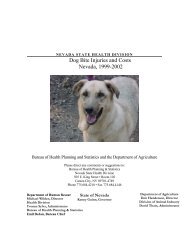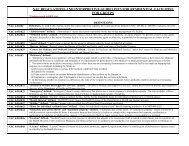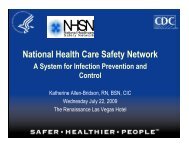Skin Cancer Profile - Nevada State Health Division - State of Nevada
Skin Cancer Profile - Nevada State Health Division - State of Nevada
Skin Cancer Profile - Nevada State Health Division - State of Nevada
You also want an ePaper? Increase the reach of your titles
YUMPU automatically turns print PDFs into web optimized ePapers that Google loves.
<strong>Skin</strong><br />
<strong>Cancer</strong><br />
<strong>Pr<strong>of</strong>ile</strong><br />
Overview and<br />
Evaluation <strong>of</strong> <strong>Skin</strong><br />
<strong>Cancer</strong> in the <strong>State</strong><br />
<strong>of</strong> <strong>Nevada</strong><br />
March 15, 2006<br />
Department <strong>of</strong><br />
<strong>Health</strong> and Human<br />
Services<br />
<strong>Nevada</strong> <strong>State</strong> <strong>Health</strong><br />
<strong>Division</strong><br />
Bureau <strong>of</strong> Community<br />
<strong>Health</strong><br />
Comprehensive <strong>Cancer</strong><br />
Control Program<br />
Kenny C. Guinn, Governor<br />
Michael J. Willden, Director<br />
Department <strong>of</strong> <strong>Health</strong><br />
and Human Services<br />
Alex Haartz, MPH, Administrator<br />
<strong>Nevada</strong> <strong>State</strong> <strong>Health</strong> <strong>Division</strong><br />
Bradford Lee, M.D.<br />
<strong>State</strong> <strong>Health</strong> Officer
<strong>Skin</strong> <strong>Cancer</strong> <strong>Pr<strong>of</strong>ile</strong><br />
Overview and Evaluation <strong>of</strong> <strong>Skin</strong><br />
<strong>Cancer</strong> in the <strong>State</strong> <strong>of</strong> <strong>Nevada</strong><br />
March 15, 2006<br />
Thomas Lee, M.Ed., <strong>Health</strong> Program Specialist I<br />
Department <strong>of</strong> <strong>Health</strong> and Human Services<br />
<strong>Nevada</strong> <strong>State</strong> <strong>Health</strong> <strong>Division</strong><br />
Bureau <strong>of</strong> Community <strong>Health</strong><br />
Comprehensive <strong>Cancer</strong> Control Program
Spring 2006<br />
Dear Friends,<br />
<strong>Skin</strong> care and skin cancer are an issue <strong>of</strong> vital importance.<br />
In fact, one type <strong>of</strong> skin cancer, melanoma can and does hit close to home. As a family,<br />
we know this all too well with the loss <strong>of</strong> a parent and sibling.<br />
What is important is that there is a growing body <strong>of</strong> knowledge and awareness that can<br />
mitigate this growing threat.<br />
<strong>Nevada</strong> has so much to <strong>of</strong>fer with its natural beauty. We can enjoy our outdoor lifestyle<br />
through proactive awareness that includes skin protection and timely monitoring <strong>of</strong><br />
changes to our skin.<br />
This report provides the blueprint for a healthier <strong>Nevada</strong> by following the three “S”s <strong>of</strong><br />
skin care: sensitivity to sun exposure, self-examination and seeking timely medical<br />
treatment.<br />
At <strong>Nevada</strong>’s <strong>of</strong>ficial cancer institute, we are making skin cancer one <strong>of</strong> our highest<br />
priorities. We look forward to being your partner in improving the odds in this and other<br />
cancer areas.<br />
Sincerely,<br />
Heather Murren<br />
President and CEO<br />
Jim Murren<br />
Member, Board <strong>of</strong> Directors
<strong>Skin</strong> <strong>Cancer</strong> <strong>Pr<strong>of</strong>ile</strong> for <strong>Nevada</strong><br />
Acknowledgment goes to the following individuals for their<br />
contribution to the <strong>Nevada</strong> <strong>Skin</strong> <strong>Cancer</strong> <strong>Pr<strong>of</strong>ile</strong><br />
Charlene Herst Program Manager, Tobacco Prevention and Education<br />
Program, Bureau <strong>of</strong> Community <strong>Health</strong>, <strong>Nevada</strong> <strong>State</strong><br />
<strong>Health</strong> <strong>Division</strong><br />
Deborah McBride, MBA Chief, Bureau <strong>of</strong> Community <strong>Health</strong>, <strong>Nevada</strong> <strong>State</strong><br />
<strong>Health</strong> <strong>Division</strong><br />
Ihsan Azzam, M.D., MPH <strong>Nevada</strong> <strong>State</strong> Epidemiologist, Office <strong>of</strong> Epidemiology,<br />
<strong>Nevada</strong> <strong>State</strong> <strong>Health</strong> <strong>Division</strong><br />
Tanya Reid, M.A. Education and Information Officer, <strong>Nevada</strong> Environmental<br />
Public <strong>Health</strong> Tracking System, Bureau <strong>of</strong> Community<br />
<strong>Health</strong>, <strong>Nevada</strong> <strong>State</strong> <strong>Health</strong> <strong>Division</strong><br />
Wei Yang, Ph.D. <strong>State</strong> Biostatistician, Center for <strong>Health</strong> Data & Research,<br />
Bureau <strong>of</strong> <strong>Health</strong> Planning & Statistics, <strong>Nevada</strong> <strong>State</strong><br />
<strong>Health</strong> <strong>Division</strong><br />
William Lee, B.S. Biostatistician, Center for <strong>Health</strong> Data & Research,<br />
Bureau <strong>of</strong> <strong>Health</strong> Planning & Statistics, <strong>Nevada</strong> <strong>State</strong><br />
<strong>Health</strong> <strong>Division</strong><br />
Megan Corradino, MPH Biostatistician, Center for <strong>Health</strong> Data & Research,<br />
Bureau <strong>of</strong> <strong>Health</strong> Planning & Statistics, <strong>Nevada</strong> <strong>State</strong><br />
<strong>Health</strong> <strong>Division</strong><br />
Milton Eisner, Ph.D. <strong>Cancer</strong> Statistics Branch, Surveillance Research Program,<br />
National <strong>Cancer</strong> Institute<br />
2
Executive Summary<br />
3
Executive Summary<br />
<strong>Skin</strong> cancer is the most prevalent <strong>of</strong> all cancers in the United <strong>State</strong>s. The American <strong>Cancer</strong><br />
Society estimates that over 1 million new nonmelanoma cancers will be diagnosed in 2005 and<br />
the majority <strong>of</strong> these are directly related to exposure to the sun. In addition, an estimated 59,350<br />
cases <strong>of</strong> melanoma, another form <strong>of</strong> skin cancer that is more aggressive and potentially fatal, will<br />
be diagnosed in 2005. The ability to play and work safely is attainable with minor lifestyle<br />
modifications that limit direct exposure to the sun and increased awareness <strong>of</strong> these types <strong>of</strong><br />
cancer. The use <strong>of</strong> sunscreens, limiting exposure during specific times <strong>of</strong> day, adjusting attire,<br />
and self-examination are just some <strong>of</strong> the recommendations proposed to decrease the risk for<br />
skin cancers.<br />
The quality <strong>of</strong> life in the state <strong>of</strong> <strong>Nevada</strong> is a primary stimulus for the exponential growth the<br />
state is experiencing. One <strong>of</strong> the key factors in this growth is the overall climate <strong>of</strong> <strong>Nevada</strong>.<br />
Promotional literature <strong>of</strong>ten refers to the abundant number <strong>of</strong> sunshine days. Outdoor life and<br />
activities have been, and will be, an integral component <strong>of</strong> the allure for those seeking a variety<br />
<strong>of</strong> recreational endeavors. In addition to recreational pursuits, many <strong>Nevada</strong>ns find themselves<br />
in outdoor settings in their pr<strong>of</strong>essional roles. Regardless <strong>of</strong> the reason, <strong>Nevada</strong>ns and others<br />
who visit are drawn to the variety <strong>of</strong> outdoor venues the state has to <strong>of</strong>fer. This lifestyle also<br />
places many individuals at risk for potential health issues related to skin cancer.<br />
In defining the quality <strong>of</strong> life in <strong>Nevada</strong>, one should also include the ability to pursue endeavors<br />
free <strong>of</strong> risk from potential harm. <strong>Skin</strong> cancer poses a real threat to the residents <strong>of</strong> the state. A<br />
risk that could be realistically reduced or minimized simply by eliminating overexposure to the<br />
sun and other forms <strong>of</strong> ultraviolet (UV) radiation (e.g., tanning beds, sunlamps). There will<br />
always remain factors related to genetic predispositions, prior behaviors and lifestyle, and other<br />
components that are difficult to address. However, skin cancers can significantly be reduced<br />
through a variety <strong>of</strong> simple changes in behavior. This pr<strong>of</strong>ile will address the current state <strong>of</strong><br />
skin cancers nationally and in <strong>Nevada</strong>, trends in education and prevention, and recommendations<br />
for interventions.<br />
The intent <strong>of</strong> this pr<strong>of</strong>ile is to present an overview <strong>of</strong> the types, causes, and prevalence <strong>of</strong> skin<br />
cancers. The public health implications related to skin cancers, both nationally and in <strong>Nevada</strong>,<br />
are significant and, in some cases, ignored or overshadowed by other diseases. <strong>Skin</strong> cancers are<br />
the most prevalent types <strong>of</strong> cancer and one <strong>of</strong> the most preventable forms <strong>of</strong> cancer.<br />
<strong>Skin</strong> cancer affects the epithelial tissues <strong>of</strong> the skin and causes either structural damage to the<br />
tissues or mutation to the DNA <strong>of</strong> cells. Solar or other forms <strong>of</strong> radiation are acknowledged as<br />
the primary cause <strong>of</strong> most skin cancers. The two primary types <strong>of</strong> radiation linked to skin<br />
cancers are UV-A and UV-B, with UV-B radiation strongly linked to the more aggressive forms<br />
<strong>of</strong> skin cancer. The types <strong>of</strong> cancer range from the less invasive forms, such as squamous and<br />
basal cell, to the more aggressive forms such as melanoma. A number <strong>of</strong> risk factors affect the<br />
incidence <strong>of</strong> skin cancers and environmental factors play a significant part in the disease process.<br />
There is a higher prevalence and mortality by race (whites), by gender (men), and by age (35-84<br />
year olds). Time was a critical factor related to overall survival. Early intervention, especially<br />
with melanoma, had a direct relationship to the overall survival rate. The most important factor<br />
4
elated to the survival <strong>of</strong> melanoma was the locus <strong>of</strong> diagnosis, which is also a time critical<br />
component and accounted for a difference in survival rates <strong>of</strong> 98 percent with a localized<br />
diagnosis down to 16 percent with a distal diagnosis.<br />
Statistically, skin cancers, in general, account for the majority <strong>of</strong> all types <strong>of</strong> cancers with<br />
aggressive forms (i.e., melanoma) accounting for approximately 10 percent. Mortality rates vary<br />
depending upon the type <strong>of</strong> cancer, with melanomas mortality rates ranging from 20 - 25 percent<br />
depending on reporting year. <strong>Nevada</strong> has a significantly higher rate <strong>of</strong> melanoma than the<br />
national average and with additional refinements in the data collection systems will, in all<br />
probability, have a higher rate <strong>of</strong> skin cancer in general compared to the national average.<br />
The complexity <strong>of</strong> skin cancer and the simplicity <strong>of</strong> intervention are strangely paradoxical. The<br />
facts, the anatomy and physiology, the demographics, and the statistics all converge into a simple<br />
cause and effect relationship. If exposed to adequate levels <strong>of</strong> radiation for an extended period,<br />
one will have a high risk <strong>of</strong> acquiring skin cancer. <strong>Nevada</strong>ns are in an environment with a<br />
positive sun social norm, long periods <strong>of</strong> high UV radiation, and demographics nurturing for skin<br />
cancers. These elements are reflected in the current state <strong>of</strong> prevalence and mortality. The<br />
intervention strategies are simple: decrease the amount <strong>of</strong> exposure to radiation, self-examine for<br />
early skin cancer identification, and seek medical treatment as soon as possible. Implementation<br />
strategies involve provision <strong>of</strong> educational resources, the changing <strong>of</strong> behaviors, and the<br />
acknowledgement that the sun and other forms <strong>of</strong> radiation are potentially dangerous. Although<br />
the plan is simple, human nature and change are always complex adversaries.<br />
5
Table <strong>of</strong> Contents<br />
6
Table <strong>of</strong> Contents<br />
Executive Summary.......................................................................................................................4<br />
Overview and Evaluation <strong>of</strong> <strong>Skin</strong> <strong>Cancer</strong> in the <strong>State</strong> <strong>of</strong> <strong>Nevada</strong>...........................................10<br />
Method..................................................................................................................................10<br />
Results...................................................................................................................................11<br />
Anatomy <strong>of</strong> the <strong>Skin</strong> .....................................................................................................11<br />
Types <strong>of</strong> <strong>Skin</strong> <strong>Cancer</strong>....................................................................................................12<br />
<strong>Skin</strong> <strong>Cancer</strong> Distribution, Incidence, and Mortality .....................................................12<br />
Ultraviolet Light (UV) ..................................................................................................13<br />
Risk Factors...................................................................................................................13<br />
Prevention .....................................................................................................................14<br />
Discussion .............................................................................................................................14<br />
Overview <strong>of</strong> <strong>Skin</strong> <strong>Cancer</strong>..............................................................................................14<br />
Risk Factors...................................................................................................................15<br />
<strong>Skin</strong> <strong>Cancer</strong> Interventions.............................................................................................15<br />
Incidence and Mortality <strong>of</strong> <strong>Skin</strong> <strong>Cancer</strong> in <strong>Nevada</strong>......................................................16<br />
Data Variations and Implications .........................................................................16<br />
Evaluation <strong>of</strong> National Data on <strong>Skin</strong> <strong>Cancer</strong>........................................................17<br />
Evaluation <strong>of</strong> <strong>Nevada</strong> Data on <strong>Skin</strong> <strong>Cancer</strong> .........................................................21<br />
Comparison <strong>of</strong> National versus <strong>Nevada</strong> Data.......................................................29<br />
Conclusion............................................................................................................................31<br />
Appendix A:..................................................................................................................................34<br />
References .............................................................................................................................34<br />
Appendix B:..................................................................................................................................37<br />
Glossary.................................................................................................................................37<br />
7
Appendix C:..................................................................................................................................40<br />
<strong>Nevada</strong> Deaths Due to Malignant Melanomas 1998 - 2002..................................................40<br />
Appendix D:..................................................................................................................................46<br />
Detailed Types <strong>of</strong> <strong>Cancer</strong> 2000 - 2003..................................................................................46<br />
Appendix E:..................................................................................................................................49<br />
Incidence <strong>of</strong> Melanoma per 100,000 (Age Adjusted) ...........................................................49<br />
Appendix F: ..................................................................................................................................51<br />
Table <strong>of</strong> Figures.....................................................................................................................51<br />
8
<strong>Skin</strong> <strong>Cancer</strong> <strong>Pr<strong>of</strong>ile</strong><br />
Overview and Evaluation <strong>of</strong> <strong>Skin</strong><br />
<strong>Cancer</strong> in the <strong>State</strong> <strong>of</strong> <strong>Nevada</strong><br />
9
Overview and Evaluation <strong>of</strong> <strong>Skin</strong> <strong>Cancer</strong> in the <strong>State</strong> <strong>of</strong> <strong>Nevada</strong><br />
<strong>Skin</strong> cancer is the most prevalent <strong>of</strong> all cancers in the United <strong>State</strong>s. The American <strong>Cancer</strong><br />
Society estimates that over 1 million new nonmelanoma cancers will be diagnosed in 2005 and<br />
the majority <strong>of</strong> these are directly related to exposure to the sun. In addition, an estimated 59,350<br />
cases <strong>of</strong> melanoma, another form <strong>of</strong> skin cancer that is more aggressive and potentially fatal, will<br />
be diagnosed in 2005. The ability to play and work safely is attainable with minor lifestyle<br />
modifications that limit direct exposure to the sun and increased awareness <strong>of</strong> these types <strong>of</strong><br />
cancer. The use <strong>of</strong> sunscreens, limiting exposure during specific times <strong>of</strong> day, adjusting attire,<br />
and self-examination are just some <strong>of</strong> the recommendations proposed to decrease the risk for<br />
skin cancers.<br />
The quality <strong>of</strong> life in the state <strong>of</strong> <strong>Nevada</strong> is a primary stimulus for the exponential growth the<br />
state is experiencing. One <strong>of</strong> the key factors in this growth is the overall climate <strong>of</strong> <strong>Nevada</strong>.<br />
Promotional literature <strong>of</strong>ten refers to the abundant number <strong>of</strong> sunshine days. Outdoor life and<br />
activities have been, and will be, an integral component <strong>of</strong> the allure for those seeking a variety<br />
<strong>of</strong> recreational endeavors. In addition to recreational pursuits, many <strong>Nevada</strong>ns find themselves<br />
in outdoor settings in their pr<strong>of</strong>essional roles. Regardless <strong>of</strong> the reason, <strong>Nevada</strong>ns and others<br />
who visit are drawn to the variety <strong>of</strong> outdoor venues the state has to <strong>of</strong>fer. This lifestyle also<br />
places many individuals at risk for potential health issues related to skin cancer.<br />
In defining the quality <strong>of</strong> life in <strong>Nevada</strong>, one should also include the ability to pursue endeavors<br />
free <strong>of</strong> risk from potential harm. <strong>Skin</strong> cancer poses a real threat to the residents <strong>of</strong> the state. A<br />
risk that could be realistically reduced or minimized simply by eliminating overexposure to the<br />
sun and other forms <strong>of</strong> ultraviolet (UV) radiation (e.g., tanning beds, sunlamps). There will<br />
always remain factors related to genetic predispositions, prior behaviors and lifestyle, and other<br />
components that are difficult to address. However, skin cancers can significantly be reduced<br />
through a variety <strong>of</strong> simple changes in behavior. This pr<strong>of</strong>ile will address the current state <strong>of</strong><br />
skin cancers nationally and in <strong>Nevada</strong>, trends in education and prevention, and recommendations<br />
for interventions.<br />
Method<br />
A general search for information was conducted through various internet search engines, as well<br />
as focused searches for information from specific national sites related to cancer research.<br />
National sites included the American <strong>Cancer</strong> Society – <strong>Skin</strong> <strong>Cancer</strong> Facts and <strong>Cancer</strong> Reference<br />
Information: Overview – <strong>Skin</strong> <strong>Cancer</strong> – Melanoma; Centers for Disease Control and Prevention<br />
(CDC), National Center for Chronic Disease Prevention and <strong>Health</strong> Promotion – 2005/2005 Fact<br />
Sheet <strong>Skin</strong> <strong>Cancer</strong>: Preventing America’s Most Common <strong>Cancer</strong>; The University <strong>of</strong> Texas: MD<br />
Anderson <strong>Cancer</strong> Center – <strong>Skin</strong> <strong>Cancer</strong>; and the University <strong>of</strong> California, Irvine: UCI Medical<br />
Center – Types <strong>of</strong> <strong>Skin</strong> <strong>Cancer</strong>.<br />
Statistical information was obtained from the Centers for Disease Control and Prevention (CDC),<br />
National Center for Chronic Disease Prevention and <strong>Health</strong> Promotion – <strong>Cancer</strong> Prevention and<br />
Control; the American <strong>Cancer</strong> Society; the National <strong>Cancer</strong> Institute – Surveillance<br />
Epidemiology and End Results (SEER); the National <strong>Cancer</strong> Institute – <strong>State</strong> <strong>Cancer</strong> <strong>Pr<strong>of</strong>ile</strong>s;<br />
10
The North American Association <strong>of</strong> Central <strong>Cancer</strong> Registries – CINA + Online; the <strong>State</strong> <strong>of</strong><br />
<strong>Nevada</strong> - <strong>Health</strong> <strong>Division</strong>, Bureau <strong>of</strong> <strong>Health</strong> Planning and Statistics – <strong>Nevada</strong> Interactive <strong>Health</strong><br />
Database (NIHDS); <strong>Nevada</strong> Center for <strong>Health</strong> Data and Research – Report on <strong>Cancer</strong> in <strong>Nevada</strong><br />
1997-2001; and the United <strong>Health</strong> Foundation, America’s <strong>Health</strong>: <strong>State</strong> <strong>Health</strong> Rankings 2004<br />
Edition – <strong>Cancer</strong> Deaths. Special reports were generated by the <strong>State</strong> <strong>of</strong> <strong>Nevada</strong> - <strong>Health</strong><br />
<strong>Division</strong>, Bureau <strong>of</strong> <strong>Health</strong> Planning and Statistics for skin cancer mortality rates specific to<br />
melanoma in <strong>Nevada</strong> 1998 - 2002.<br />
Results<br />
The research yielded information specific to the anatomical structure <strong>of</strong> the skin, and the disease<br />
process, regarding the effects <strong>of</strong> radiation on particular structures. The data highlighted the<br />
ramifications <strong>of</strong> skin cancer at cellular levels, the types <strong>of</strong> skin cancer, and the distribution,<br />
incidence, and mortality <strong>of</strong> the various types <strong>of</strong> skin cancers. It also clearly evaluated the effects<br />
<strong>of</strong> ultraviolet light (UV) on the skin and the implications related to skin cancer; and the risk<br />
factors and prevention strategies, including discussion <strong>of</strong> controversial or inconclusive research<br />
related to prevention.<br />
Anatomy <strong>of</strong> the <strong>Skin</strong><br />
<strong>Skin</strong> is a type <strong>of</strong> epithelial tissue that is comprised <strong>of</strong> layers <strong>of</strong> cells. The outermost layer is<br />
composed <strong>of</strong> squamous cells on a base layer referred to as the basal lamina or basement<br />
membrane (Figure 1). The skin is the<br />
largest organ <strong>of</strong> the body and serves a<br />
number <strong>of</strong> functions including protection,<br />
absorption, and excretion. The skin also<br />
serves in temperature control, sensation,<br />
and pain reception. Epithelial cells are<br />
avascular, meaning the cells are not<br />
nourished by an active blood supply and<br />
are reliant on the connective tissues for<br />
nutrients through absorption.<br />
Melanocytes, which regulate<br />
pigmentation <strong>of</strong> the skin, are located in<br />
the lower layers <strong>of</strong> the skin and in close<br />
proximity to the connective tissues. The<br />
physical levels <strong>of</strong> the skin have a direct<br />
correlation to specific cancers, the<br />
consequences to UV exposure, and<br />
ultimately outcomes related to survival<br />
rates.<br />
Figure 1: (Appendix F - page 51)<br />
11
Types <strong>of</strong> <strong>Skin</strong> <strong>Cancer</strong><br />
The research and information reviewed categorized cancers into nonmelanoma and melanoma<br />
types. The nonmelanoma cancers mentioned were squamous cell and basal cell carcinomas,<br />
while melanoma exclusively represented the remaining category. Nationally, the nonmelanoma<br />
category accounts for a little over 90 percent <strong>of</strong> all skin cancers, but it also tends to have a low<br />
mortality rate. Conversely, melanoma types <strong>of</strong> cancers have an incidence rate <strong>of</strong> approximately<br />
5.6 percent, but account for 74 percent <strong>of</strong> all skin cancer related deaths. The successful<br />
treatment outcomes and survival rates for nonmelanoma type cancers are high with early<br />
intervention and proper treatment. Basal cell cancers are rarely fatal and tend to spread slowly.<br />
Squamous cell cancers also spread slowly with a low mortality rate, but can be fatal if treatment<br />
and intervention is delayed.<br />
Melanoma cancers however spread quickly and are much more aggressive. They have variable<br />
outcomes and survival rates that correlate directly with early intervention and treatment.<br />
Melanoma also has a mortality prediction rate relative to the location (i.e., local, regional, or<br />
distal) <strong>of</strong> the cancer at the time <strong>of</strong> diagnosis. Localized melanoma occurs in melanocytes in the<br />
lower layers <strong>of</strong> the skin, regionalized melanoma has invaded into other tissues adjacent to the<br />
skin, and the most aggressive type is the distal form, which has migrated to other regions <strong>of</strong> the<br />
body (e.g., lungs, brain, bone, etc.) Currently, the rate <strong>of</strong> diagnosis for melanoma at a local site<br />
is 93 percent. The range <strong>of</strong> survival over a five year period is 98 percent if found locally with<br />
early intervention but drops dramatically to 16 percent if found at a distal site. Exposure to the<br />
sun is consistently noted in most <strong>of</strong> the research as one <strong>of</strong> the main factors attributed to all three<br />
types <strong>of</strong> cancers. Additionally, exposure to UV-B radiation is believed to cause mutations in the<br />
DNA <strong>of</strong> melanocytes and consequently is the major causal factor in the formation <strong>of</strong> melanoma<br />
types <strong>of</strong> cancer.<br />
<strong>Skin</strong> <strong>Cancer</strong> Distribution, Incidence, and Mortality<br />
The state <strong>of</strong> <strong>Nevada</strong> has a significantly higher incidence rate <strong>of</strong> both skin cancer (excluding<br />
squamous and basal) and melanoma than the national average. Melanoma is the fifth leading<br />
type <strong>of</strong> cancer in <strong>Nevada</strong> and accounts for 6.7 percent <strong>of</strong> all cancers in the state. There is a<br />
significant gender discrepancy in both incidence and mortality rates, with men more at risk than<br />
women. Men were also more prone to contracting skin cancer regardless <strong>of</strong> race, with whites<br />
more prone to contracting skin cancers than African-Americans or Hispanics. White men were<br />
most at risk for contracting skin cancers <strong>of</strong> both types and subsequently dying from the disease.<br />
Age is also a significant factor in skin cancers, with incidence and mortality increasing into the<br />
middle years and then maintaining a fairly consistent pattern throughout the remainder <strong>of</strong> the age<br />
spectrum until the 85+ age group. This distribution pattern is consistent with the premise that<br />
over time additional exposures to UV radiation and the cumulative cellular damage to the skin is<br />
progressive. It also demonstrates the extent <strong>of</strong> the general population that is at risk for these<br />
types <strong>of</strong> cancers.<br />
12
Ultraviolet Light (UV)<br />
The effects <strong>of</strong> sunlight, tanning beds, and other forms <strong>of</strong> UV radiation were consistently noted in<br />
the literature as a significant risk factor in the causes <strong>of</strong> skin cancers <strong>of</strong> all types. The incidences<br />
<strong>of</strong> squamous and basal forms <strong>of</strong> skin cancer were considered direct consequences <strong>of</strong><br />
overexposure to the sun or other UV producing light sources. The direct physical damage to<br />
cells secondary to exposure was considered the primary cause <strong>of</strong> cancerous lesions. The<br />
contribution <strong>of</strong> UV radiation in the formation <strong>of</strong> melanoma was less clear, but the general<br />
consensus was that exposure <strong>of</strong> melanocytes to UV-B radiation created changes in the DNA <strong>of</strong><br />
the cells, which in turn created mutation within the cells.<br />
The use <strong>of</strong> sunscreen was germane to this discussion and remains at the center <strong>of</strong> controversy<br />
related to the premise that sunscreen causes cancers. The discussion relates to studies reflecting<br />
increased incidence <strong>of</strong> skin cancer in individuals using various sunscreens or sunblocks. The<br />
latest studies show no direct link between sunscreen and increased incidence, but does note that<br />
individuals using sunscreen are <strong>of</strong>ten those with increased risk factors. There was also<br />
discussion regarding this same group extending their exposure to the sun or other radiation<br />
sources because <strong>of</strong> the belief and misconception that sunscreen would provide enough protection<br />
to mitigate the additional risk from extended exposure.<br />
Risk Factors<br />
Risk factors were consistently noted across resources and were similar between nonmelanoma<br />
and melanoma types <strong>of</strong> skin cancer. As with any medical condition, the risk factors range<br />
through the spectrum <strong>of</strong> physical predispositions, behavioral choices, and environmental<br />
influences. As noted in previous sections, changing exposure to UV radiation is the primary<br />
intervention consistently cited in the literature. The risk factors consistently cited in the<br />
literature were:<br />
• Exposure to UV radiation (sun, sunlamp, tanning beds)<br />
• Fair complexion<br />
• Occupational exposure to coal tar, pitch, creosote, arsenic compounds, or radium<br />
• Family history<br />
• Multiple or atypical moles<br />
• Immune suppression<br />
• Age<br />
• Gender<br />
• Severe sunburns as a child<br />
• Xeroderma Pigmentosum<br />
• Past history <strong>of</strong> melanoma<br />
13
Prevention<br />
The primary methods and approach to skin cancer prevention in the literature follows an<br />
avoidance and surveillance precept. Interventions such as decreasing UV radiation exposure,<br />
utilizing sunscreens and sunblocks, altering exposure times, and changing clothing choices were<br />
a few <strong>of</strong> the examples recommended for prevention. Self-examination techniques and the close<br />
observation <strong>of</strong> moles, etc. form the foundation for the skin cancer surveillance process. The<br />
interventions are easy to learn, easy to implement, and require minimal financial resources. The<br />
major challenges for implementation are the dissemination <strong>of</strong> information, the education <strong>of</strong><br />
health pr<strong>of</strong>essionals, the education <strong>of</strong> the public, and the changing <strong>of</strong> human behaviors. As with<br />
most health related situations, motivations seem to appear more readily after the diagnosis <strong>of</strong> the<br />
disease.<br />
Overview <strong>of</strong> <strong>Skin</strong> <strong>Cancer</strong><br />
Discussion<br />
In the world <strong>of</strong> modern medicine, complexity can be the reality and the norm. The human<br />
physiology can be daunting and medical interventions many times require extensive planning<br />
and resources. <strong>Skin</strong> cancer, in contrast, is rather straightforward and the cause and effect process<br />
relative to skin cancer is quite simple. The more exposure one has to Ultraviolet (UV) Rays, the<br />
greater the risk for contracting skin cancer in one form or another. The form appears to be in<br />
direct relationship to the extent or level <strong>of</strong> damage to the skin over time. The damage incurred<br />
during childhood in the form <strong>of</strong> sunburns can have a devastating effect on the health <strong>of</strong> the<br />
young adult. The addition <strong>of</strong> a variety <strong>of</strong> risk factors, as with any disease, also increases the<br />
chances <strong>of</strong> contracting skin cancer.<br />
The layered structure <strong>of</strong> the skin is designed to protect the human body from a number <strong>of</strong><br />
dangers, as well as perform a number <strong>of</strong> functions related to temperature control, absorption, and<br />
sensation. The exposure <strong>of</strong> these layers <strong>of</strong> the skin to UV radiation and the damage incurred<br />
from the exposure is also reflected in the type and severity <strong>of</strong> skin cancers. The American<br />
<strong>Cancer</strong> Society estimates that more than 1 million cases <strong>of</strong> nonmelanoma types <strong>of</strong> cancer will be<br />
diagnosed every year in the United <strong>State</strong>s. The nonmelanoma cancers include basal cell and<br />
squamous cell types <strong>of</strong> skin cancer. These types <strong>of</strong> cancers constitute 90 percent <strong>of</strong> all skin<br />
cancer and are usually treated in a physician’s <strong>of</strong>fice. These types <strong>of</strong> cancer are not currently<br />
classified as a reportable disease, so the full extent <strong>of</strong> incidence remains unknown. Basal cell<br />
cancers usually grow at a very slow rate and are rarely lethal. Nevertheless, there is a possibility<br />
<strong>of</strong> disfigurement and considerable damage to the skin which can require extensive reconstruction<br />
and discomfort. Basal cell cancers reflect damage to the underlying layer <strong>of</strong> the skin or what is<br />
referred to as the basal lamina. Squamous cell cancer is the second type <strong>of</strong> nonmelanoma cancer.<br />
It is less common than basal cell cancer, but can be more dangerous. The squamous cells make<br />
up the outer layer <strong>of</strong> the skin and form the first line <strong>of</strong> defense for the body. As with basal cell<br />
cancer, the damage is primarily to the structure <strong>of</strong> the skin, but this form <strong>of</strong> cancer grows at a<br />
faster rate and can be fatal if not treated appropriately. Both types <strong>of</strong> cancer primarily manifest<br />
as localized tissue damage and the damage is primarily physical in nature.<br />
14
The more invasive forms <strong>of</strong> skin cancer, and potentially more lethal types, include melanoma,<br />
which represents less than 10 percent <strong>of</strong> all skin cancers, but it is responsible for roughly 74<br />
percent <strong>of</strong> all skin cancer deaths. Melanoma forms when melanocytes, which are cells in the<br />
lower levels <strong>of</strong> the skin, are damaged and the DNA structure <strong>of</strong> the cells changes or mutates.<br />
Melanocytes are instrumental to skin pigmentation, and the darkening or tanning process. The<br />
physical location <strong>of</strong> these cells is in close proximity to the connective tissues, which, unlike the<br />
skin, has a viable blood supply. The change or mutation in these cells and the possibility <strong>of</strong><br />
migration through the blood supply make this type <strong>of</strong> skin cancer a serious health threat.<br />
Survival is in direct relationship to the location <strong>of</strong> the melanoma at the time <strong>of</strong> diagnosis.<br />
Melanoma can manifest locally, regionally, or distally, and the distal forms are <strong>of</strong>ten referred to<br />
as metastatic melanoma. At present, approximately 83 percent <strong>of</strong> all melanoma cases are<br />
diagnosed at the local stage. The five year survival rate for melanoma diagnosed at the local<br />
stage is approximately 98 percent. Melanoma diagnosed at the regional stage has a drop in the<br />
five year survival rate to 60 percent, and at the distal stage survival drops to 16 percent.<br />
Risk Factors<br />
As with all disease, risk factors constitute an important part <strong>of</strong> the equation regarding contracting<br />
or being predisposed to a particular disorder. <strong>Skin</strong> cancer also has genetic, environmental, and<br />
behavioral factors that can increase or decrease the potential for acquiring the disease.<br />
Individuals with a fair complexion, a family history, multiple or atypical moles, Xeroderma<br />
Pigmentosum, and a past history <strong>of</strong> melanoma are at higher risk due to their genetic makeup.<br />
Individuals exposed to coal tar, pitch, creosote, arsenic compounds, or radium as a part <strong>of</strong> their<br />
occupation, those receiving various medical treatments, and those that are immune suppressed<br />
are at higher risk. Finally, the behavioral factors such as sunburns as a child or duration <strong>of</strong><br />
exposure to UV radiation weigh heavily on the equation.<br />
The significance <strong>of</strong> this discussion lies in the potential to alter outcomes through change in<br />
attitudes and behavior. Exposure to UV radiation is cited as the major cause in nonmelanoma<br />
types <strong>of</strong> cancer and a significant factor in the development <strong>of</strong> melanoma type cancer. The two<br />
types <strong>of</strong> UV radiation, UV-A and UV-B, have been found to cause damage to the skin and the<br />
general consensus is that no type <strong>of</strong> UV radiation is safe. UV-B type radiation has been found to<br />
cause damage to the DNA <strong>of</strong> melanocyte cells, which is the primary cause attributed to the<br />
development <strong>of</strong> melanoma. It would follow that decreasing exposure would in turn decrease the<br />
incidence <strong>of</strong> skin cancers. Therefore, simple adjustments in behavior by individuals, especially<br />
individuals with significant risk factors, would dramatically change the incidence and mortality<br />
related to skin cancer.<br />
<strong>Skin</strong> <strong>Cancer</strong> Interventions<br />
The development <strong>of</strong> effective intervention procedures for skin cancer requires reasonable<br />
educational, behavioral, and personal surveillance components, as well as modification <strong>of</strong><br />
individual beliefs toward UV radiation exposure, and personal responsibility. Some <strong>of</strong> the<br />
elements <strong>of</strong> change include decreasing the length <strong>of</strong> exposure to UV Radiation, altering the times<br />
<strong>of</strong> radiation exposure to avoid high intensity hours, adjusting clothing choices to provide<br />
15
additional coverage, and properly applying appropriate sunscreens. These interventions<br />
combined with monitoring moles, monthly skin self-examination, and early treatment would<br />
dramatically decrease the mortality attributed to skin cancer, especially melanoma. Perhaps the<br />
most difficult obstacle to overcome in early intervention strategies with skin cancer may be the<br />
current perception <strong>of</strong> the sun as health enhancing and the misconception <strong>of</strong> radiation sources as<br />
benign entities.<br />
Incidence and Mortality <strong>of</strong> <strong>Skin</strong> <strong>Cancer</strong> in <strong>Nevada</strong><br />
Data Variations and Implications<br />
The evaluation <strong>of</strong> data relative to cancer in general, and skin cancer specifically, proved more<br />
difficult than expected. The methodology, classification, the variety in application <strong>of</strong> census<br />
data, and lag time in reporting made the analysis <strong>of</strong> data intensely challenging. Although the<br />
reporting systems have improved significantly over the past five years, these mechanisms, both<br />
nationally and in <strong>Nevada</strong>, are still in an evolutionary state. As the various systems coordinate<br />
and refine the communication process, the quality <strong>of</strong> shared information and data will continue<br />
to improve over time, which will create a better overall picture regarding skin cancers throughout<br />
the nation. The negative impact in evaluation and analysis <strong>of</strong> skin cancers in the short term will<br />
be the lack <strong>of</strong> clarity regarding the true dimensions <strong>of</strong> the incidence and mortality for these<br />
cancers and the potential delays or possible failure to mobilize resources appropriate to address<br />
the full extent <strong>of</strong> the problem.<br />
Figure 2: (Appendix F - page 52)<br />
16
In general, the nationally recognized organizations on cancer have underestimated, for the most<br />
part, both the incidence and mortality rates for cancer in <strong>Nevada</strong> (Figure 2). There are a number<br />
<strong>of</strong> explanations for this discrepancy, but the most apparent one may simply be that the reporting<br />
and communication systems between states and national entities are still in an evolutionary<br />
status. The conversion <strong>of</strong> organizations to the age adjusted calculations based on the census <strong>of</strong><br />
2000 may also account for the shifting <strong>of</strong> incidence.<br />
Other issues include inconsistencies in nomenclature (i.e., ICD codes included in specific cancer<br />
diagnosis, or melanoma diagnosed at distal locations), limitations in staffing resources for<br />
updating registry numbers, and delays in reporting times. The National <strong>Cancer</strong> Institute<br />
estimates these delays in reporting to be twenty-two months from the end <strong>of</strong> a reporting year to<br />
the actual time <strong>of</strong> reporting nearly two years later. The most recent data available for evaluation<br />
in <strong>Nevada</strong> is from the year 2003, but these figures remain incomplete at this time. The sharp<br />
increase in the incidence <strong>of</strong> melanoma in <strong>Nevada</strong> from 477 to 623 between reporting years 2002<br />
and 2003 is alarming, but whether this increase is predictive remains unknown. Most assuredly,<br />
these numbers will increase and the best predictors <strong>of</strong> significance will occur when the<br />
calculations converting the overall numbers into an incidence per 100,000 format is completed<br />
and available for evaluation. What is disconcerting is the potential that the total numbers will<br />
escalate considerably in the interim between the years 2003 – 2005.<br />
Evaluation <strong>of</strong> National Data on <strong>Skin</strong> <strong>Cancer</strong><br />
Irrespective <strong>of</strong> the data variations, the numbers regarding incidence and percentages <strong>of</strong> the types<br />
<strong>of</strong> cancers, the gender implications, racial incidence and mortality, and age distribution have<br />
been consistent over various agencies and organizations. The general trend for skin cancers<br />
reflect a steady increase in incidence with a peak in incidence occurring in reporting year 2001<br />
(Figure 3). Mortality rates followed a similar trend as the incidence data with a slight <strong>of</strong>fset in<br />
time by one to two years, which would logically follow considering the nature and course <strong>of</strong> the<br />
diagnosis and treatment cycle <strong>of</strong> the disease. Shifting to the age adjusted calculations based on<br />
the 2000 census may possibly account for some aspects <strong>of</strong> these trends, but additional<br />
observation and reporting would be required to make a definitive statement regarding incidence<br />
and mortality.<br />
The National <strong>Cancer</strong> Institute estimates there will be 66,000 people diagnosed with some form <strong>of</strong><br />
skin cancer in 2005 nationally. Of this group, 59,580 or a little over 90 percent <strong>of</strong> these<br />
individuals will be diagnosed with melanoma, which is potentially the most dangerous and lethal<br />
<strong>of</strong> the skin cancers (Figure 4). These estimates also reflect a consistent trend in gender<br />
prevalence for skin cancer. A greater percentage <strong>of</strong> men, approximately 57 percent, are<br />
diagnosed with skin cancers.<br />
17
Figure 3: (Appendix F - page 53)<br />
Figure 4: (Appendix F - page 54)<br />
18
The data additionally reflected an increased incidence in whites and men (Figure 5). In<br />
perspective, the observation in respect to race was predictable based on risk factors. The gender<br />
variance remains less clear and any observation would be mere speculation. The data regarding<br />
mortality rates is consistent with the aforementioned observations (Figure 6). Mortality rates in<br />
men are more than twice the rate for women and white men have a mortality rate more than three<br />
and half times the rate for black men.<br />
Figure 5: (Appendix F - page 55)<br />
As with gender and race, age distributions followed a specific and predictable course. The<br />
development <strong>of</strong> skin cancer is by nature a slowly progressive condition exacerbated by repetitive<br />
exposure to UV radiation. The data reflects that there is a direct correlation between progression<br />
in age and an increase in skin cancer incidence and mortality. An increase in incidence begins to<br />
escalate in the 20-34 year old age group, peaks in the 45-54 year old age group, and declines<br />
slowly throughout the remaining age groups until it sharply decline in the 85+ age group (Figure<br />
7). The explanation for the decrease in incidence for the 85+ age group may simply be the lack<br />
<strong>of</strong> surviving individuals remaining with related risk factors due to attrition from skin cancers or a<br />
variety <strong>of</strong> other disease process.<br />
19
Figure 6: (Appendix F - page 56)<br />
Mortality rates followed a similar course, but once again with a slight temporal shift (Figure 8).<br />
The elapsed time between diagnosis, treatment, and a terminal diagnosis would account for the<br />
shift in time and shows the severity <strong>of</strong> melanoma relative to time. As noted in previous<br />
discussions, the locus <strong>of</strong> diagnosis in melanoma is critical to initial survival and the potential for<br />
long-term recovery. Time is ultimately the most crucial determining factor in the progression <strong>of</strong><br />
skin cancer and early diagnosis is critical to a positive potential for survival. Therefore, the<br />
increased incidence and mortality reflected in the data would appear consistent with the normal<br />
course <strong>of</strong> progression for skin cancers.<br />
20
Figure 7: (Appendix F - page 57)<br />
Evaluation <strong>of</strong> <strong>Nevada</strong> Data on <strong>Skin</strong> <strong>Cancer</strong><br />
The unique climate, geography, health care logistics, and demographics <strong>of</strong> <strong>Nevada</strong> combine to<br />
create a complex and challenging public health environment. The bulk <strong>of</strong> <strong>Nevada</strong>’s population<br />
is concentrated in two urban areas with one additional emerging urban area. The remaining<br />
population is distributed over large areas with limited resources in the extreme locales. <strong>Nevada</strong><br />
has a wide range <strong>of</strong> geographical features and terrains from low to high desert with an abundant<br />
number <strong>of</strong> sunny days. The National Weather Service, in the Monthly Means and Maximums<br />
data for Las Vegas, rated the UV Index as High to Very High six to seven months out <strong>of</strong> the year<br />
(Figure 9). The number <strong>of</strong> sunny days, the intensity <strong>of</strong> the UV radiation, and the outdoor<br />
lifestyle in <strong>Nevada</strong> presents an environment with maximal risk for the development <strong>of</strong> skin<br />
cancers.<br />
21
Figure 8: (Appendix F - page 58)<br />
Additional risk factors associated with the development <strong>of</strong> skin cancer in relation to the<br />
demographic distributions within <strong>Nevada</strong> further increases the risk potential. The combination<br />
<strong>of</strong> these factors also presents a difficult environment for quality data acquisition. The <strong>Nevada</strong><br />
<strong>State</strong> <strong>Health</strong> <strong>Division</strong>, through the Bureau <strong>of</strong> <strong>Health</strong> Planning and Statistics, has and continues to<br />
develop infrastructure to increase the accuracy and quality <strong>of</strong> data in <strong>Nevada</strong>. As the reporting<br />
systems improve and the data becomes better defined, verifiable trends are emerging in wide<br />
range <strong>of</strong> public health concerns. As the data collection process has improved, an alarming trend<br />
is evolving which appears to support the premise that <strong>Nevada</strong>ns are in fact at high risk for the<br />
development <strong>of</strong> skin cancers.<br />
22
Figure 9: (Appendix F - page 59)<br />
The initial discussion <strong>of</strong> the data analysis process for <strong>Nevada</strong> incidence and mortality rates must<br />
include a brief dialog about the evolution <strong>of</strong> the data collection within the state system. In the<br />
<strong>Nevada</strong> Report on <strong>Cancer</strong> in <strong>Nevada</strong> 1997 – 2001, a discussion on the limitations <strong>of</strong> data pre-<br />
1999 referred to the potential pitfalls in adequately portraying trends and creating credible<br />
predictions based on the current data. The changes in reporting related to age adjusting and the<br />
2000 census may have also created shifts in baselines that are clearly apparent between the 1999<br />
and 2000 reporting period. One should rationally question a jump in incidence rates <strong>of</strong> nearly<br />
two and a half times over a one year span if not given context for the shift (Figure 10). The<br />
subsequent presentations and the emerging data specific to melanoma will show a definite underreporting<br />
in previous years <strong>of</strong> both incidence and mortality for skin cancer in the state <strong>of</strong> <strong>Nevada</strong>.<br />
23
Figure 10: (Appendix F - page 60)<br />
The incidence <strong>of</strong> skin cancers in <strong>Nevada</strong> and the associated breakouts for specific sub-types <strong>of</strong><br />
skin cancers showed a much higher incidence and percentage rate <strong>of</strong> melanoma than expected<br />
relative to the totals for all skin cancers (Figures 10 and 11). The number <strong>of</strong> cases and the range<br />
<strong>of</strong> percentage for incidence <strong>of</strong> melanoma in <strong>Nevada</strong> from 1998 – 2001 was 93.0 - 95.4 percent,<br />
with the percentage actually increasing as the quality <strong>of</strong> the data improved over time. The<br />
disturbing implication <strong>of</strong> this observation is that people in <strong>Nevada</strong> are contracting a potentially<br />
lethal skin cancer at a much higher rate than expected and the total numbers are continuing to<br />
increase. Out <strong>of</strong> the context <strong>of</strong> the incidence rate per 100,000, it is difficult to say definitively at<br />
this time in which direction the trend is moving.<br />
24
Figure 11: (Appendix F - page 61)<br />
The evaluation <strong>of</strong> data specific to skin cancer in <strong>Nevada</strong> presented additional challenges<br />
regarding ICD coding and the matching <strong>of</strong> similar types <strong>of</strong> cancers categorized within the <strong>Skin</strong><br />
<strong>Cancer</strong> (Excluding Basal and Squamous) designation. This dilemma remains unresolved at this<br />
time.<br />
The data on melanoma, however, was specific and served as the benchmark for comparisons in<br />
the evaluation <strong>of</strong> trends related to skin cancer. The quality <strong>of</strong> the melanoma data provided<br />
reasonable assurance that assumptions and predictions were defensible and conclusions tenable.<br />
The general ratio <strong>of</strong> melanoma to total skin cancer in <strong>Nevada</strong> made observations generally<br />
predictive, but would require additional clarification <strong>of</strong> coding and a more in depth study to<br />
make the numbers for all categories <strong>of</strong> skin cancer specifically predictive. The melanoma data<br />
for <strong>Nevada</strong> has similar trends and percentages within specific groups, although the overall<br />
numbers have reflected a sharp increase in overall cases diagnosed (Figure 12).<br />
As mentioned earlier, reporting has increased significantly since the year 2000 in <strong>Nevada</strong>. The<br />
increase in population in general in <strong>Nevada</strong> can also be a factor in the increase in cases in general<br />
since 1998. Perhaps the most significant observations made about melanoma were in the<br />
25
Figure 12: (Appendix F - page 62)<br />
incidence rate per 100,000. The numbers have increased significantly since 1998, but the rate<br />
has shown stabilization over the years 2000 – 2002 (Figure 13). The data collection and<br />
reporting process appears functional and the numbers reflected are essentially an accurate<br />
representation <strong>of</strong> melanoma cancer in <strong>Nevada</strong>. Unfortunately, the numbers reflected are<br />
significantly high relative to the national data.<br />
The data related to gender was consistent with national data, with men representing the majority<br />
<strong>of</strong> both incidence and mortality figures for melanoma. In the overall numbers for <strong>Nevada</strong>, men<br />
represented a significant portion <strong>of</strong> the mortality count and the percentage for melanoma (Figure<br />
14). There appears to be no clear explanation for the variance in rates related to gender and any<br />
theory ventured would be supposition.<br />
26
Figure 13: (Appendix F - page 63)<br />
Figure 14: (Appendix F - page 64)<br />
27
The data related to age distribution was also consistent with national figures and information.<br />
The specific progression <strong>of</strong> skin cancer in general dictates the incidence and mortality<br />
progression within age groups. The consequences <strong>of</strong> an environment with a naturally high UV<br />
radiation index, multiple exposures over time and a population demographic with multiple risk<br />
factors are reflected in the consistent age related incidence and mortality <strong>of</strong> melanoma (Figures<br />
15 and 16).<br />
Once again, the distribution for incidence shows a sharp increase beginning in the 35 – 44 year<br />
old age group and sustains throughout the 75-84 year old age group. What is <strong>of</strong> note is the<br />
incidence rates increase to approximately 45 – 50 per 100,000 in the 45 – 54 year old age group<br />
and then shows another spike in the 65 – 74 year old age group. The corresponding increases in<br />
mortality rates per 100,000, for similar but not precisely matched age groupings, reflect a<br />
mortality percentage <strong>of</strong> 20.9 - 23.4 percent or approximately 1:5 ratio <strong>of</strong> mortality to incidence.<br />
Figure 15: (Appendix F - page 65)<br />
28
Figure 16: (Appendix F - page 66)<br />
Comparison <strong>of</strong> National versus <strong>Nevada</strong> Data<br />
Although the information on skin cancer generally, and to melanoma specifically, in <strong>Nevada</strong> was<br />
compelling, the most dramatic case is made in the comparisons with national information. The<br />
figures for <strong>Nevada</strong> were so far out <strong>of</strong> sync with nationally reported data that there was an<br />
assumption made that the information was incorrect or misreported. The <strong>Nevada</strong> Bureau <strong>of</strong><br />
<strong>Health</strong> Planning and Statistics subsequently rechecked the information to determine the accuracy<br />
<strong>of</strong> the data. The outcome <strong>of</strong> their inquiry verified that the spike in numbers shown initially in the<br />
years 2000 and 2001 were in fact accurate (Figure 17).<br />
Even though the general information related to skin cancer remained tentative and the use <strong>of</strong> the<br />
data potentially risky, the numbers for melanoma were both substantial and reliable. One can<br />
make the argument that the overall numbers for skin cancer will always exceed the specific<br />
numbers for melanoma based solely on the data being inclusive <strong>of</strong> melanoma in the overall skin<br />
cancer category. For the scope, content, and context <strong>of</strong> this report, the data for melanoma will<br />
suffice for the <strong>Nevada</strong> and national comparative analysis. The most appropriate and accurate<br />
comparative data is reflected in the incidence <strong>of</strong> melanoma per 100,000 (Figure 18). It is also<br />
the most illustrative <strong>of</strong> the issues related to skin cancer facing <strong>Nevada</strong> in comparison to the<br />
national situation.<br />
29
Figure 17: (Appendix F - page 67)<br />
The additional information provided for the year 2002 in the data for melanoma in figure 18<br />
further illuminates the elevated incidence rate for melanoma in <strong>Nevada</strong>. The information also<br />
provides validation <strong>of</strong> the quality <strong>of</strong> data in relationship to national figures and trends. In the<br />
context <strong>of</strong> the comparison, <strong>Nevada</strong>’s rates have shown consistency in incidence trends relative to<br />
national rates, except with a much higher incidence. The elevated variance for <strong>Nevada</strong>, during<br />
the years 2000 – 2002, has ranged from 4.85 – 5.93 incidences per 100,000, which translates to<br />
1.27 – 1.34 times more incidence in <strong>Nevada</strong> than the national average for melanoma. As<br />
mentioned previously, these numbers were initially questioned regarding their validity and were<br />
verified as accurate.<br />
With this said, the next issue <strong>of</strong> contention considered was the possibility <strong>of</strong> a large confidence<br />
interval, which would significantly minimize the variance. The confidence interval was<br />
established at the 95 percent level for all data and even considering the maximums and<br />
minimums <strong>of</strong> the lower and upper figures, the rate <strong>of</strong> variance remained substantial. Ultimately,<br />
these figures were determined to be accurate and the validity <strong>of</strong> the variance documented. The<br />
conclusion was that <strong>Nevada</strong> in fact has a significantly elevated incidence <strong>of</strong> melanoma and a<br />
potentially elevated incidence rate for other types <strong>of</strong> skin cancer.<br />
30
Figure 18: (Appendix F - page 68)<br />
Conclusion<br />
The intent <strong>of</strong> this pr<strong>of</strong>ile has been to present an overview <strong>of</strong> the types, causes, and prevalence <strong>of</strong><br />
skin cancers. The public health implications related to skin cancers, both nationally and in<br />
<strong>Nevada</strong>, are significant and, in some cases, ignored or overshadowed by other diseases. <strong>Skin</strong><br />
cancers are the most prevalent types <strong>of</strong> cancer and one <strong>of</strong> the most preventable forms <strong>of</strong> cancer.<br />
<strong>Skin</strong> cancer affects the epithelial tissues <strong>of</strong> the skin and causes either structural damage to the<br />
tissues or mutation to the DNA <strong>of</strong> cells. Solar or other forms <strong>of</strong> radiation are acknowledged as<br />
the primary cause <strong>of</strong> most skin cancers. The two primary types <strong>of</strong> radiation linked to skin<br />
cancers are UV-A and UV-B, with UV-B radiation strongly linked to the more aggressive forms<br />
<strong>of</strong> skin cancer. The types <strong>of</strong> cancer range from the less invasive forms, such as squamous and<br />
basal cell, to the more aggressive forms such as melanoma. A number <strong>of</strong> risk factors affect the<br />
incidence <strong>of</strong> skin cancers and environmental factors play a significant part in the disease process.<br />
There is a higher prevalence and mortality by race (whites), by gender (men), and by age (35-84<br />
year olds). Time was a critical factor related to overall survival. Early intervention, especially<br />
with melanoma, had a direct relationship to the overall survival rate. The most important factor<br />
related to the survival <strong>of</strong> melanoma was the locus <strong>of</strong> diagnosis, which is also a time critical<br />
31
component and accounted for a difference in survival rates <strong>of</strong> 98 percent with a localized<br />
diagnosis down to 16 percent with a distal diagnosis.<br />
Statistically, skin cancers, in general, account for the majority <strong>of</strong> all types <strong>of</strong> cancers with<br />
aggressive forms (i.e., melanoma) accounting for approximately 10 percent. Mortality rates vary<br />
depending upon the type <strong>of</strong> cancer, with melanomas mortality rates ranging from 20 – 25 percent<br />
depending on reporting year. <strong>Nevada</strong> has a significantly higher rate <strong>of</strong> melanoma than the<br />
national average and with additional refinements in the data collection systems will, in all<br />
probability, have a higher rate <strong>of</strong> skin cancer in general compared to the national average.<br />
The complexity <strong>of</strong> skin cancer and the simplicity <strong>of</strong> intervention are strangely paradoxical. The<br />
facts, the anatomy and physiology, the demographics, and the statistics all converge into a simple<br />
cause and effect relationship. If exposed to adequate levels <strong>of</strong> radiation for an extended period,<br />
one will have a high risk <strong>of</strong> acquiring skin cancer. <strong>Nevada</strong>ns are in an environment with a<br />
positive sun social norm, long periods <strong>of</strong> high UV radiation, and demographics nurturing for skin<br />
cancers. These elements are reflected in the current state <strong>of</strong> prevalence and mortality. The<br />
intervention strategies are simple: decrease the amount <strong>of</strong> exposure to radiation, self-examine for<br />
early skin cancer identification, and seek medical treatment as soon as possible. Implementation<br />
strategies involve provision <strong>of</strong> educational resources, the changing <strong>of</strong> behaviors, and the<br />
acknowledgement that the sun and other forms <strong>of</strong> radiation are potentially dangerous. Although<br />
the plan is simple, human nature and change are always complex adversaries.<br />
32
Appendix A:<br />
33
Appendix A:<br />
References<br />
American <strong>Cancer</strong> Society. <strong>Cancer</strong> Facts and Figures 2001. [Online] Available:<br />
http://www.cancer.org.<br />
American <strong>Cancer</strong> Society. Prevention and Early Detection - <strong>Skin</strong> <strong>Cancer</strong> Facts.<br />
http://www.cancer.org.<br />
Centers for Disease Control and Prevention - National Center for Chronic Disease and <strong>Health</strong><br />
Promotion. National Program <strong>of</strong> <strong>Cancer</strong> Registries.<br />
http://www.cdc.gov/cancer/npcr/uscs/index.htm.<br />
Centers for Disease Control and Prevention - National Center for Chronic Disease and <strong>Health</strong><br />
Promotion. 2004/2005 Fact Sheet, <strong>Skin</strong> <strong>Cancer</strong>: Preventing America’s Most Common<br />
<strong>Cancer</strong>. http://www.cdc.gov/cancer/nscpep/about2004.htm.<br />
Hemmings, M., Yang, W., DeJan, E., (2001). <strong>State</strong> <strong>of</strong> <strong>Nevada</strong> <strong>Health</strong> <strong>Division</strong> - Bureau <strong>of</strong><br />
<strong>Health</strong> Planning and Statistics: <strong>Nevada</strong> Report on <strong>Cancer</strong>.<br />
http://health2k.state.nv.us/nihds/publications/1997.2001Report/Report.pdf.<br />
MedicineNet.com. MedTerms Medical Dictionary. http://www.medterms.com/script/main/hp.asp<br />
Merriam-Webster Online. Merriam-Webster Online Dictionary. http://www.merriamwebster.com/<br />
National <strong>Cancer</strong> Institute – <strong>Skin</strong> <strong>Cancer</strong> (PDQ). Prevention. http://seer.cancer.gov.<br />
National <strong>Cancer</strong> Institute - <strong>Cancer</strong> Stat Facts. <strong>Cancer</strong> <strong>of</strong> the <strong>Skin</strong> (Excl. Basal and Squamous).<br />
http://seer.cancer.gov/statfacts/html/skin.html?statfacts_page=skin.html&x=16&y=12.<br />
National <strong>Cancer</strong> Institute - <strong>Cancer</strong> Stat Facts. Melanoma <strong>of</strong> the <strong>Skin</strong>.<br />
http://seer.cancer.gov/statfacts/html/melan.html?statfacts_page=melan.html<br />
&x=15&y=15.<br />
National <strong>Cancer</strong> Institute - <strong>State</strong> <strong>Cancer</strong> <strong>Pr<strong>of</strong>ile</strong>s. Melanoma <strong>of</strong> the <strong>Skin</strong>.<br />
http://statecancerpr<strong>of</strong>iles.cancer.gov/cgibin/incidencerates/incidencerates.html.<br />
National <strong>Cancer</strong> Institute – Statistical Research and Applications Branch. <strong>Cancer</strong> Incidence<br />
Rates Adjusted for Reporting Delay. http://srab.cancer.gov/delay/<br />
National Oceanic and Atmospheric Administration, National Weather Service, Climate<br />
Prediction Center. UV Index: Monthly Means and Maximums.<br />
http://www.cpc.ncep.noaa.gov/products/stratosphere/uv_index/.<br />
34
Ries LAG, Eisner MP, Kosary CL, Hankey BF, Miller BA, Clegg L, Mariotto A, Fay MP, Feuer<br />
EJ, Edwards BK (eds). SEER <strong>Cancer</strong> Statistics Review, 1975-2000, National <strong>Cancer</strong><br />
Institute. Bethesda, MD.<br />
Saraiya, M., Glanz, K., Briss, P., Nichols, P., White, C., & Das, D. (2003, October 17).<br />
Preventing <strong>Skin</strong> <strong>Cancer</strong> Findings <strong>of</strong> the Task Force on Community Preventitive Services<br />
on Reducing Exposure to Ultraviolet Light. Morbidity and Mortality Weekly Report, 52,<br />
No RR 15; 1. http://www.cdc.gov/mmwr/preview/mmwrhtml/rr5215a1.htm.<br />
<strong>State</strong> <strong>of</strong> <strong>Nevada</strong> <strong>Health</strong> <strong>Division</strong>, Bureau <strong>of</strong> <strong>Health</strong> Planning and Statistics (2005). <strong>Nevada</strong><br />
Deaths Due To Malignant Melanomas 1998 – 2002 – Special Report. Carson City, NV.<br />
October 10, 2005.<br />
<strong>State</strong> <strong>of</strong> <strong>Nevada</strong> <strong>Health</strong> <strong>Division</strong>, Bureau <strong>of</strong> <strong>Health</strong> Planning and Statistics (2005). Detailed<br />
Types <strong>of</strong> <strong>Cancer</strong> 2000 - 2003 – Special Report. Carson City, NV. November 2, 2005.<br />
<strong>State</strong> <strong>of</strong> <strong>Nevada</strong> <strong>Health</strong> <strong>Division</strong> - Bureau <strong>of</strong> <strong>Health</strong> Planning and Statistics. <strong>Nevada</strong> Interactive<br />
<strong>Health</strong> Database – <strong>Cancer</strong> Module.<br />
http://health2k.state.nv.us/nihds/measures/cancer/long_form.html?.<br />
<strong>State</strong> <strong>of</strong> <strong>Nevada</strong> <strong>Health</strong> <strong>Division</strong>, Bureau <strong>of</strong> <strong>Health</strong> Planning and Statistics (2005). Incidence <strong>of</strong><br />
Melanoma per 100,000 (Age Adjusted) 2000 - 2002 – Special Report. Carson City, NV.<br />
November 3, 2005.<br />
The North American Association <strong>of</strong> Central <strong>Cancer</strong> Registries, CINA + Online. 1998 - 2001<br />
<strong>Skin</strong> <strong>Cancer</strong> (Excluding Basal and Squamous ) and Melanoma.<br />
http://www.naaccr.org/cinap/index.htm.<br />
The <strong>Skin</strong> <strong>Cancer</strong> Foundation Journal (2004, March 24). Does Sunscreen Cause <strong>Cancer</strong>? Iowa<br />
Researchers Say No. New York, NY. http://www.skincancer.org/news/040324melanoma.php.<br />
United <strong>Health</strong> Foundation, America’s <strong>Health</strong>: <strong>State</strong> <strong>Health</strong> Rankings – 2004 Edition. <strong>Cancer</strong><br />
Deaths. http://www.unitedhealthfoundation.org/shr2004/components/cancerdeaths.html.<br />
The University <strong>of</strong> Texas, MD Anderson <strong>Cancer</strong> Center. <strong>Skin</strong> <strong>Cancer</strong>.<br />
http://www.mdanderson.org.<br />
University <strong>of</strong> California, Irvine, UCI Medical Center. Types <strong>of</strong> <strong>Skin</strong> <strong>Cancer</strong>.<br />
http://www.ucihealth.com.<br />
U.S Preventative Services Task Force (2003). Counseling to Prevent <strong>Skin</strong> <strong>Cancer</strong>:<br />
Recommendations and Rationale. October 2003. Agency for <strong>Health</strong>care Research and<br />
Quality, Rockville, MD. http://www.ahrq.gov/clinic/3rduspstf/skcacoun/skcarr.htm.<br />
35
Appendix B:<br />
36
Appendix B:<br />
Glossary<br />
Distal - Situated away from the point <strong>of</strong> attachment or origin or a central point especially <strong>of</strong> the<br />
body<br />
Epithelial – The adjective related to the noun epithelium<br />
Epithelium - A membranous cellular tissue that covers a free surface or lines a tube or cavity <strong>of</strong><br />
an animal body and serves especially to enclose and protect the other parts <strong>of</strong> the body, to<br />
produce secretions and excretions, and to function in assimilation<br />
Local - Of, relating to, or characteristic <strong>of</strong> a particular place: not general or widespread, relating<br />
to, or applicable to part <strong>of</strong> a whole, involving or affecting only a restricted part <strong>of</strong> the organism<br />
Metastasis - Change <strong>of</strong> position, state, or form: as a transfer <strong>of</strong> a disease-producing agency from<br />
the site <strong>of</strong> disease to another part <strong>of</strong> the body or a secondary metastatic growth <strong>of</strong> a malignant<br />
tumor<br />
Melanocyte - An epidermal cell that produces melanin<br />
Radiation – The action or process <strong>of</strong> radiating, the process <strong>of</strong> emitting radiant energy in the<br />
form <strong>of</strong> waves or particles, or the combined processes <strong>of</strong> emission, transmission, and absorption<br />
<strong>of</strong> radiant energy (e.g., related to skin cancer, the ultraviolet radiation in sunlight or other light<br />
sources)<br />
Regional - Any <strong>of</strong> the major subdivisions into which the body or one <strong>of</strong> its parts is divisible, an<br />
indefinite area surrounding a specified body part, affecting a particular region (e.g., a pain in the<br />
region <strong>of</strong> the heart)<br />
Ultraviolet - Situated beyond the visible spectrum at its violet end, radiation having a<br />
wavelength shorter than wavelengths <strong>of</strong> visible light and longer than those <strong>of</strong> X rays, relating to,<br />
producing, or employing ultraviolet radiation<br />
Ultraviolet Radiation -A & B (UV-A, UV-B) - One <strong>of</strong> the three types <strong>of</strong> invisible light rays<br />
(together with ultraviolet B and ultraviolet C) given <strong>of</strong>f by the sun. Ultraviolet A and ultraviolet<br />
B, on the other hand, do penetrate the ozone layer in attenuated form and reach the surface <strong>of</strong> the<br />
planet. Because ultraviolet A is weaker than ultraviolet B, scientists long blamed ultraviolet B as<br />
the sole culprit in causing skin cancer in persons with a history <strong>of</strong> sunburn and repeated<br />
overexposure to ultraviolet radiation. Recent research, however, has also implicated ultraviolet A<br />
as a possible cause <strong>of</strong> skin cancer. In addition to natural light from the sun, artificial light from<br />
tanning lamps contains ultraviolet A and ultraviolet B.<br />
37
Ultraviolet – C (UV-C) - Although ultraviolet C is the most dangerous type <strong>of</strong> ultraviolet light<br />
in terms <strong>of</strong> its potential to harm life on earth, it cannot penetrate earth's protective ozone layer.<br />
Therefore, it poses no threat to human, animal or plant life on earth.<br />
Xeroderma Pigmentosum - A genetic condition inherited as a recessive autosomal trait that is<br />
caused by a defect in mechanisms that repair DNA mutations (as those caused by ultraviolet<br />
light) and is characterized by the development <strong>of</strong> pigment abnormalities and multiple skin<br />
cancers in body areas exposed to the sun<br />
38
Appendix C:<br />
39
Count<br />
Death<br />
Year<br />
Appendix C:<br />
<strong>State</strong> <strong>of</strong> <strong>Nevada</strong> <strong>Health</strong> <strong>Division</strong>, Bureau <strong>of</strong> <strong>Health</strong> Planning and Statistics<br />
<strong>Nevada</strong> Deaths Due to Malignant Melanomas 1998 - 2002<br />
Table 1 Death Year * ICD-10 Code<br />
Cross tabulation<br />
ICD-10 Code Total<br />
172.9 C43.3 C43.7 C43.9 C44.2 C44.3 C44.4 C44.9<br />
1998 52 0 0 0 0 0 0 0 52<br />
1999 0 1 1 55 0 3 12 6 78<br />
2000 0 0 0 47 0 2 7 7 63<br />
2001 0 0 0 62 1 0 10 5 78<br />
2002 0 0 0 57 0 2 6 5 70<br />
Total 52 1 1 221 1 7 35 23 341<br />
In order to determine the correct ICD codes used for Malignant Melanoma <strong>Skin</strong> <strong>Cancer</strong> Deaths, a<br />
cross tab was run to see the distribution <strong>of</strong> causes <strong>of</strong> death by specific ICD codes associated with<br />
skin cancer and determine the representation <strong>of</strong> each code used. Codes were obtained from the<br />
NIH National <strong>Cancer</strong> Institute, ICD-9 to ICD 10 Neoplasm’s book and the WHO International<br />
Classification <strong>of</strong> Disease for Oncology ICD-O book.<br />
After reviewing the <strong>Nevada</strong> <strong>Health</strong> <strong>Division</strong>’s interactive website and re-reviewing the ICD<br />
codes the two following ICD codes (172.9 & C43.9) were determined as the two codes to<br />
properly recognize malignant melanoma as cause <strong>of</strong> death. The selection <strong>of</strong> these two codes (and<br />
exclusion <strong>of</strong> the supplementary codes) was based on the current findings in the death data and<br />
blatant differences between current interactive website data and the above totals for each year.<br />
40
Further reading into each ICD code was also referenced to determine specific designations for<br />
each code. The following tables are created with the use <strong>of</strong> the two selected codes.<br />
Table 2 Death Year * ICD-10 Code Cross tabulation<br />
Death<br />
Year<br />
Count<br />
ICD-10 Code<br />
172.9 C43.9 Total<br />
1998 52 0 52<br />
1999 0 55 55<br />
2000 0 47 47<br />
2001 0 62 62<br />
2002 0 57 57<br />
Total 52 221 273<br />
Table 2 represents the exclusion <strong>of</strong> all other skin cancer codes aside from 172.9 & C43.9 for the<br />
years 1998 to 2002. The totals represented in the table depict an accurate representation <strong>of</strong> the<br />
number <strong>of</strong> deaths in <strong>Nevada</strong> due to malignant melanoma.<br />
Table 3 provides malignant melanoma death information for males vs. females including total<br />
percentages for <strong>Nevada</strong> residents in each <strong>of</strong> the years <strong>of</strong> 1998 thru 2002.<br />
41
Table 3 Death Year * Sex Cross tabulation<br />
42<br />
Sex Total<br />
Male Female<br />
Death Year 1998 Count 42 10 52<br />
% within death yr 80.8% 19.2% 100.0%<br />
% <strong>of</strong> Total 15.4% 3.7% 19.0%<br />
1999 Count 35 20 55<br />
% within death yr 63.6% 36.4% 100.0%<br />
% <strong>of</strong> Total 12.8% 7.3% 20.1%<br />
2000 Count 29 18 47<br />
% within death yr 61.7% 38.3% 100.0%<br />
% <strong>of</strong> Total 10.6% 6.6% 17.2%<br />
2001 Count 42 20 62<br />
% within death yr 67.7% 32.3% 100.0%<br />
% <strong>of</strong> Total 15.4% 7.3% 22.7%<br />
2002 Count 40 17 57<br />
% within death yr 70.2% 29.8% 100.0%<br />
% <strong>of</strong> Total 14.7% 6.2% 20.9%<br />
Total Count 188 85 273<br />
% within death yr 68.9% 31.1% 100.0%<br />
% <strong>of</strong> Total 68.9% 31.1% 100.0%
Table 4 Sex * <strong>State</strong> <strong>of</strong> Residence Cross tabulation<br />
43<br />
<strong>State</strong> <strong>of</strong> Residence Total<br />
Sex Male Count 188 188<br />
NV<br />
% within Sex 100.0% 100.0%<br />
% <strong>of</strong> Total 68.9% 68.9%<br />
Female Count 85 85<br />
% within Sex 100.0% 100.0%<br />
% <strong>of</strong> Total 31.1% 31.1%<br />
Total Count 273 273<br />
% within Sex 100.0% 100.0%<br />
% <strong>of</strong> Total 100.0% 100.0%<br />
Table 4 provides the malignant melanoma deaths by gender for all years 1998-2002 combined.
<strong>State</strong> <strong>of</strong><br />
Residence<br />
Table 5 <strong>State</strong> <strong>of</strong> Residence * 10 Age Groups by 10 Years Cross tabulation<br />
44<br />
10 Age Groups by 10 Years Total<br />
20-29 30-39 40-49 50-59 60-69 70-79 80-89 90+<br />
NV Count 5 18 43 53 57 64 31 2 273<br />
% within <strong>State</strong> <strong>of</strong><br />
Residence<br />
1.8% 6.6% 15.8% 19.4% 20.9% 23.4% 11.4% .7% 100.0%<br />
% <strong>of</strong> Total 1.8% 6.6% 15.8% 19.4% 20.9% 23.4% 11.4% .7% 100.0%<br />
Total Count 5 18 43 53 57 64 31 2 273<br />
% within <strong>State</strong> <strong>of</strong><br />
Residence<br />
1.8% 6.6% 15.8% 19.4% 20.9% 23.4% 11.4% .7% 100.0%<br />
% <strong>of</strong> Total 1.8% 6.6% 15.8% 19.4% 20.9% 23.4% 11.4% .7% 100.0%<br />
Table 5 provides the distribution <strong>of</strong> malignant melanoma deaths by age group for the years 1998<br />
to 2002.
Appendix D:<br />
45
Appendix D:<br />
<strong>State</strong> <strong>of</strong> <strong>Nevada</strong> <strong>Health</strong> <strong>Division</strong>, Bureau <strong>of</strong> <strong>Health</strong> Planning and Statistics<br />
Detailed Types <strong>of</strong> <strong>Cancer</strong> 2000 - 2003<br />
Detailed Type <strong>of</strong> <strong>Cancer</strong>, ICD-O Code * Year <strong>of</strong> Diagnosis Cross tabulation<br />
Detailed<br />
Type <strong>of</strong><br />
<strong>Cancer</strong>,<br />
ICD-O<br />
Code<br />
Count<br />
46<br />
Year <strong>of</strong> Diagnosis<br />
2000 2001 2002 2003 Total<br />
Melanomas Of The <strong>Skin</strong> 454 477 477 623 * 2031<br />
Other Non-Epithelial <strong>Skin</strong><br />
40 58 38 42 178<br />
* - 2003 Preliminary count for melanoma in <strong>Nevada</strong> with total count incomplete at this time
Melanomas Of The <strong>Skin</strong><br />
11 Age Groups by 10 Years * Year <strong>of</strong> Diagnosis Cross tabulation<br />
11 Age<br />
Groups<br />
by 10<br />
Years<br />
Count<br />
Year <strong>of</strong> Diagnosis<br />
2000 2001 2002 2003 Total<br />
Appendix E:<br />
48
Appendix E:<br />
<strong>State</strong> <strong>of</strong> <strong>Nevada</strong> <strong>Health</strong> <strong>Division</strong>, Bureau <strong>of</strong> <strong>Health</strong> Planning and Statistics<br />
Incidence <strong>of</strong> Melanoma per 100,000 (Age Adjusted)<br />
49
Appendix F:<br />
50
Appendix F:<br />
Table <strong>of</strong> Figures<br />
51

















